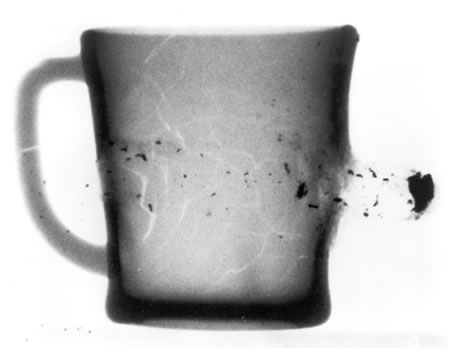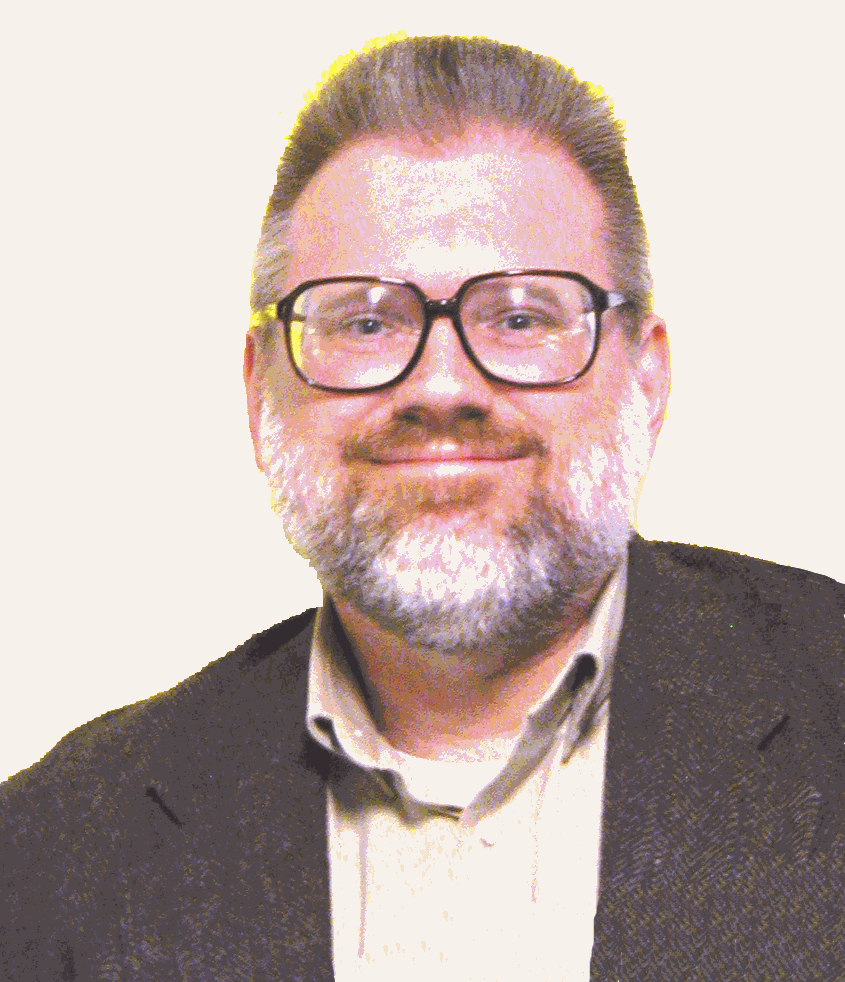
Wilhelm Roentgen, discoverer of X-rays, with 1895 radiograph (inset) of his wife's hand.

Flash radiograph of a bullet passing through a coffee mug. (Courtesy Titan PSD)
 Wilhelm Roentgen, discoverer of X-rays, with 1895 radiograph (inset) of his wife's hand. |
 Flash radiograph of a bullet passing through a coffee mug. (Courtesy Titan PSD) |
The range of commercially available units will be described and their strengths and limitations noted. The importance of source spot size on image quality will be emphasized. The tradeoff of size and capability will be obvious. The importance of careful high-voltage design and pulsed power engineering techniques will be illustrated. Several research flash radiation machines will be described based on both diode and accelerator-driven sources.
The relatively recent development of high-current, linear induction accelerator technology will be described and machines such as FXR (Flash X-Ray) at Livermore, and the Dual-Axis Radiographic Hydrodynamics Test (DARHT) at Los Alamos will be presented. These accelerators produce kiloamp electron beams to multi-MeV potentials and deliver high-quality, millimeter-sized beams to Bremstrahlung-based targets. The development of these machines has been accompanied by key breakthroughs in pulsed power, target development, and in the modeling of beam transport and mitigation of beam instabilities. The speaker will describe some of the key issues and technologies involved in fielding these large machines.
Finally, a novel diode source will be described that is under development as a collaboration between LLNL, the Naval Research Laboratory, and Bechtel Nevada. Capable of diagnostic support in many flash x-ray applications, this source utilizes a compact Marx generator driving a rod-pinch diode. Radiographic goals are to produce at least 0.5 rads at 1 m in a pulsewidth of less than 50 ns with a spectral end point above 1 MeV from a spot size less than 1 mm. The source shows promise for a wide range of flash radiographic needs from a device that is table-top sized.
This work was performed under the auspices of the U.S. Dept. of Energy by the University of California, Lawrence Livermore National Laboratory, under Contract No. W-7405-Eng-48.
 |
Lawrence Livermore National Laboratory |
Before joining the Lab, the author worked for 19 years in industrial research supporting high power microwave generation or charged particle acceleration. He has held positions at Hughes Aircraft Company, General Atomics, Varian Associates, and Physics International.
His undergraduate education was in physics and mathematics at San Diego State University. He holds an MSEE and Degree of Engineer from Stanford University in Physical Electronics. He has been a member of IEEE for over 20 years and has held memberships in the Nuclear and Plasma Sciences Society, the Electron Device Society, and the Microwave Theory and Techniques Society.
 SF Bay Area |  Berkeley |  LBL map |
Alternative route from 24-13 (Green line on map; shorter, but through residential neighborhood): On Ashby, turn right at Claremont Ave. (at gas station; second traffic light after main entrance to Claremont Hotel). Immediately bear left around the "island", with the restaurant on it. You will find yourself driving through a wrought iron and brick gateway if you have performed this maneuver properly. Proceed to the end of the street to a forced left turn onto Derby at the UC-Clark Kerr campus. Turn right at Warring at the southwest corner of the campus. After two blocks, follow the road as it bears to the left to join Piedmont Ave at the traffic light (stay in the right lane on Piedmont to avoid a forced left turn at Haste). Continue along Piedmont until it becomes Gayley Road and proceed as described in the previous paragraph.